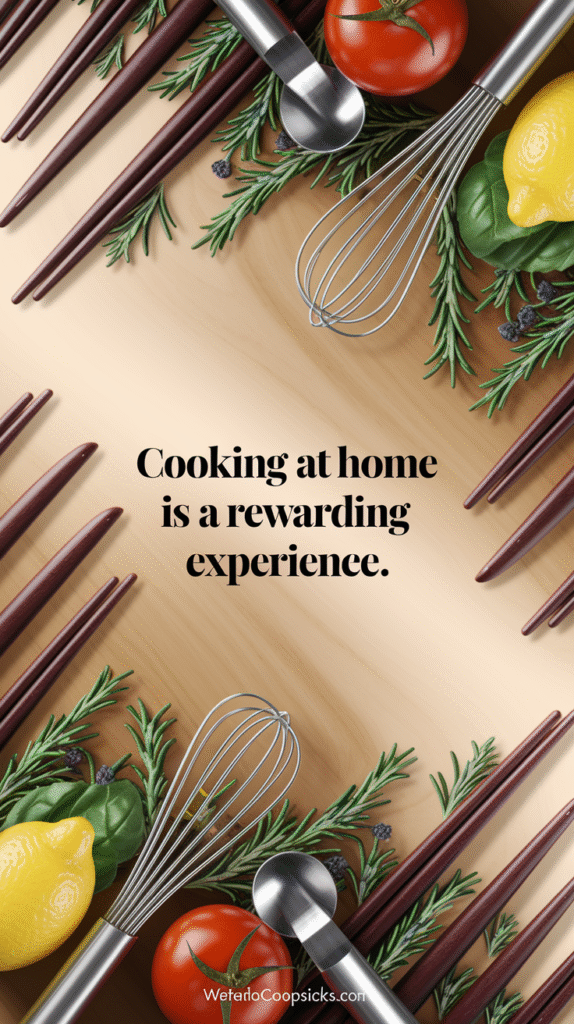Cooking at home is a rewarding experience, and having the right utensils can make all the difference in your culinary adventures. Whether you are an amateur cook or a seasoned chef, certain tools are essential for creating delicious meals with ease. Here is a look at the best cooking utensils every home chef should have.
Essential Kitchen Utensils
Starting with the basics, here are some must-have utensils:
- Chef’s Knife: This is perhaps the most important tool in any kitchen. A good chef’s knife helps you chop, slice, and dice with precision. Look for one that feels comfortable in your hand and has a well-balanced weight.
- Cutting Board: Protect your countertops and keep your knives sharp with a sturdy cutting board. Choose one made from bamboo, plastic, or wood to suit your needs.
- Measuring Cups and Spoons: Accuracy is vital in cooking. Invest in a set of measuring cups and spoons to ensure you get your ingredients just right, especially in baking.
- Wooden Spoon: A wooden spoon is perfect for stirring sauces and mixing ingredients. It’s gentle on your pots and pans, preventing scratches while ensuring a good mix.
- Spatula: A flexible spatula helps you flip pancakes or eggs with ease. Opt for a heat-resistant silicone spatula to use in non-stick pans.
Specialized Cooking Utensils
In addition to the essentials, consider adding these specialized utensils to your kitchen arsenal:
- Whisk: A whisk is essential for blending ingredients, whipping cream, and beating eggs. Invest in both a small and a medium-sized whisk for different tasks.
- Peeler: A vegetable peeler saves time and effort when preparing fruits and vegetables. Look for one with a comfortable grip for ease of use.
- Tongs: Tongs are your best friends for flipping meat on the grill or serving salads. A pair with a locking mechanism is very handy for storage.
- Slotted Spoon: This tool is important for draining liquids while serving. A slotted spoon works great for pasta or vegetables steamed in water.
Must-Have Cookware Accessories
Your cooking utensils work best with the right cookware. A few accessories to consider include:
- Non-Stick Frying Pan: Ideal for frying eggs or cooking delicate fish, a non-stick frying pan enables you to cook without the fear of sticking.
- Stock Pot: Perfect for making soups and stews, a good stock pot gives you the space to stir and simmer large batches of food.
- Baking Sheet: An essential for baking cookies, roasting vegetables, or making homemade pizza.
Kitchen Gadgets That Make Cooking Easier
Don’t overlook some handy kitchen gadgets. They can save you time and effort, making cooking more enjoyable:
- Instant Read Thermometer: Knowing the right temperature can make or break your meal. An instant-read thermometer ensures your meats are cooked perfectly.
- Food Processor: This multifunctional tool can chop, slice, and even puree your ingredients quickly.
- Can Opener: A reliable can opener means you can access canned goods without any hassle.
When investing in cooking utensils, focus on quality over quantity. It’s better to have a few excellent tools than a cluttered kitchen drawer filled with mediocre ones. Popular brands like Wüsthof for knives and Cuisinart for cookware offer great options. Check out more options at Food Network for cookware insights and ideas.
By equipping your kitchen with the best cooking utensils, you’ll be well on your way to creating delicious dishes with confidence. Remember, the joy of cooking lies not only in the meals you prepare but also in the tools you use to bring them to life.
How to Choose the Right Cooking Utensils for Your Kitchen
Choosing the right cooking utensils for your kitchen can significantly enhance your cooking experience. With so many options available, it’s important to consider a few key factors to ensure you select utensils that meet your cooking needs.
Material Matters
The first step in selecting cooking utensils is determining the material. Common materials include:
- Wood: Great for stirring and serving, wooden utensils are gentle on non-stick surfaces and are usually dishwasher safe.
- Silicone: Heat-resistant and versatile, silicone utensils can withstand high temperatures without damaging your cookware. They are also easy to clean.
- Stainless Steel: Highly durable and resistant to rust and staining, stainless steel utensils are perfect for heavy-duty tasks.
- Bamboo: Eco-friendly and lightweight, bamboo utensils won’t scratch your pots and pans and are often treated to be water-resistant.
Types of Utensils You Need
Next, consider the types of utensils that suit your cooking style. Here’s a list of fundamental utensils every kitchen should have:
- Spatula: Ideal for flipping and spreading.
- Whisk: Essential for mixing and aerating ingredients.
- Spoons: Choose a mix of slotted and solid spoons for various cooking tasks.
- Tongs: Useful for flipping meats and serving salads.
- Ladle: Perfect for serving soups and stews.
Size and Comfort
When choosing cooking utensils, size and comfort should not be overlooked. A well-sized utensil will allow you to easily maneuver in your kitchen, making the cooking process smoother. Look for utensils that feel comfortable in your hand; if possible, test them out in-store or choose brands known for ergonomic designs.
Durability and Maintenance
Investing in utensils that are durable can save you money in the long run. Here are tips on maintaining your utensils:
- Always follow the manufacturer’s washing instructions to prolong the lifespan of your utensils.
- Avoid exposing plastic utensils to high heat to prevent warping.
- Regularly check wooden utensils for cracks and treat them with mineral oil to maintain their integrity.
Color and Design
While functionality is crucial, the aesthetic appeal of your utensils can enhance your kitchen’s ambiance. Brightly colored utensils can add a fun touch, while neutral colors can provide a more classic look. Choose a design that complements your kitchen decor and resonates with your personal style.
Budget Considerations
Your budget plays a significant role in choosing cooking utensils. It’s wise to determine how much you’re willing to spend before you start shopping. High-quality utensils can be pricey, but they often last longer. Consider investing in a few key pieces while opting for budget-friendly options for less frequently used utensils.
Where to Buy Cooking Utensils
Finding the right place to buy cooking utensils can also make a difference. Local kitchen supply stores often offer a variety of options where you can touch and feel the products. Additionally, online retailers like Cool Cooking Utensils or Kitchen Traction provide detailed descriptions and customer reviews to help make your decision easier.
Testing Before Buys
If you’re unsure, purchasing utensils that come with a satisfaction guarantee can provide peace of mind. Some brands allow you to return the utensils if they don’t meet your expectations. Testing different utensils in-store can also help you make a more informed choice.
Investing time in choosing the right cooking utensils can greatly enhance your kitchen skills and make your culinary ventures more enjoyable. Armed with the right tools, you’ll find that cooking becomes easier and more fun.
The Impact of Material on Cooking Utensils Performance
When it comes to cooking, the utensils you choose significantly affect the way you prepare and enjoy your meals. The material used in cooking utensils plays a vital role in their performance, durability, and safety. Different materials each have their unique characteristics, and understanding these can help you select the best cooking utensils for your kitchen.
Types of Materials
Here’s a breakdown of some common materials used in cooking utensils, along with their characteristics:
- Wood: Wooden utensils are gentle on cookware surfaces and resist heat well. They won’t scratch non-stick pans and have an appealing natural look. However, they can harbor bacteria if not cleaned properly.
- Stainless Steel: Durable and resistant to rust, stainless steel utensils are often dishwasher safe. They conduct heat efficiently, making them great for cooking. Look for stainless steel with a high chromium content for better resistance to stains.
- Silicone: Heat-resistant and flexible, silicone utensils can easily maneuver in tight spots. They won’t scratch cookware and are safe for non-stick surfaces. However, some silicone can deform at high temperatures, so always choose high-quality brands.
- Plastic: Versatile and lightweight, plastic utensils are often cost-effective but can melt or warp with high heat. It’s crucial to check if they’re BPA-free and safe for cooking.
- Cast Iron: Known for excellent heat retention, cast iron is perfect for frying and baking. However, they require seasoning and can be heavy, affecting ease of use.
Performance Characteristics
Each material offers distinct performance characteristics that can influence your cooking experience:
Heat Conductivity
Materials like stainless steel and copper excel in heat conductivity, enabling faster cooking times. Conversely, silicone utensils are not meant for heat exposure but are excellent for mixing and stirring.
Durability
Durability varies among materials. Stainless steel and cast iron can withstand intense cooking conditions, while wooden and plastic utensils may wear down over time. Choosing high-quality options can improve longevity.
Reactivity
Certain materials, particularly aluminum, can react with acidic foods, altering flavors. Opt for non-reactive materials like glass, stainless steel, and silicone when cooking with tomatoes or vinegar-based sauces.
Safety and Maintenance
Safety is paramount in your kitchen. Here’s what to keep in mind regarding utensil materials:
- Ensure that utensils made from plastic or silicone are labeled as food-safe to avoid harmful chemicals leaching into your food.
- Wooden utensils should be maintained regularly with mineral oil to prevent cracking and reduce bacteria retention.
- Stainless steel utensils are dishwasher safe, but hand washing is preferable for longevity.
- For cast iron utensils, use properly to create a non-stick surface and avoid rusting by drying immediately after washing.
Choosing the Right Material for Your Needs
Your choice of utensils can also depend on the cooking methods you frequently use:
| Cooking Method | Ideal Utensil Material |
|---|---|
| Stir-Frying | Wood or Silicone |
| Baking | Metal or Silicone |
| Grilling | Stainless Steel |
| Making Sauces | Stainless Steel or Plastic |
| Slow Cooking | Wood or Silicone |
By selecting the right cooking utensils based on material, you can significantly improve your cooking experience and make food preparation easier. Not only will you enjoy better performance, but you will also have a safer cooking environment.
For useful resources on cooking utensils, check out Cooking Light or explore Epicurious for recommendations.
Innovative Cooking Utensils That Make Meal Prep Easier
Meal preparation can sometimes feel tedious, but innovative cooking utensils have transformed the way we approach our time in the kitchen. With the right tools at hand, you can save time, reduce effort, and enhance the cooking experience. Here are some must-have innovative cooking utensils that will simplify your meal prep.
Multi-Functional Tools
In the realm of cooking utensils, multi-functional tools are a game changer. These utensils combine several functions into one, which means less clutter in your kitchen drawers and more efficiency.
- Spiralizer: This handy tool turns vegetables like zucchini and carrots into spirals for healthy pasta alternatives.
- Measuring Cup and Spoon Combination: This utensil combines measuring cups and spoons into one, making measuring ingredients a breeze.
- Grater and Zester: A grater that also zests can help you quickly tackle tasks like shredding cheese or zesting citrus, all with one tool.
Smart Kitchen Gadgets
Smart kitchen gadgets are changing the cooking game. From timers to app-controlled devices, they enhance precision and convenience.
- Smart Thermometers: These tools connect to your phone, allowing you to monitor cooking temperatures from anywhere.
- Digital Kitchen Scales: With precision weighing, these scales ensure you measure ingredients accurately, which is essential for baking.
- Electric Knife Sharpener: Keeping your knives sharp is critical for effortless chopping. An electric sharpener provides consistent results in seconds.
Advanced Cooking Utensils
Some cooking utensils have advanced features that make them stand out from the traditional versions. These innovative designs offer unique functionalities.
- Silicone Baking Mats: Say goodbye to parchment paper! Silicone mats provide a non-stick surface for baking and can be reused multiple times, making them eco-friendly.
- Handheld Blender: This versatile tool allows you to puree soups directly in the pot, making it convenient for soups and sauces.
- Food Processor: A food processor saves you tons of time by chopping, slicing, and dicing ingredients in moments. It’s a must-have for meal prep.
Kitchen Organization Tools
Keeping your utensils organized is crucial for a smooth cooking experience. Innovative storage solutions can help you manage your kitchen more effectively.
- Magnetic Knife Holder: Rather than keeping knives in a drawer, a magnetic strip allows for easy access while keeping them safely stored.
- Utensil Holder with Compartments: This makes finding the right tool easier while keeping everything tidy.
- Spice Rack Organizer: A rotating spice rack can keep your spices visible and easily accessible, saving time during cooking.
Ergonomic Designs
Ergonomics is a growing consideration in cooking utensils. These tools are designed with comfort in mind, reducing strain on your wrists and fingers.
- Ergonomic Vegetable Peeler: A peeler that fits comfortably in your hand makes peeling vegetables much easier and quicker.
- Soft-Grip Utensils: Utensils with soft, non-slip grips allow for better control, which is particularly helpful when handling heavy pans or stirring thick mixtures.
- Adjustable Rolling Pins: These pins come with removable rings that ensure you roll dough to a perfect thickness every time, reducing frustration.
As you can see, investing in these innovative cooking utensils will make your meal prep not only easier but also more enjoyable. Whether optimizing your cooking process or enhancing your kitchen’s organization, the right tools can make all the difference. To explore innovative cooking utensils further, consider looking at resources like Serious Eats or Food Network Kitchen Tools.
These utensils into your kitchen can revolutionize your cooking habits. Ready to enhance your culinary adventures?
Tips for Maintaining and Caring for Your Cooking Utensils
When you invest in quality cooking utensils, taking good care of them can extend their lifespan and help you enjoy cooking more. Here are some effective tips to maintain and care for your cooking utensils, ensuring they stay in excellent shape for years to come.
Know Your Materials
Different materials require different care techniques. Here are some common cooking utensil materials and their ideal maintenance methods:
| Material | Care Tips |
|---|---|
| Wood | Hand wash and dry immediately. Oil periodically with food-safe mineral oil. |
| Silicone | Top-rack dishwasher safe; avoid high heat which can damage shape. |
| Stainless Steel | Dishwasher safe; avoid abrasive cleaners to prevent scratching. |
| Plastic | Check for dishwasher safety; avoid using with high heat. |
Proper Cleaning Techniques
Cleaning utensils properly is essential to remove food residues and prevent bacterial growth. Follow these simple steps for effective cleaning:
- Immediate Rinse: Rinse utensils right after use to prevent food from sticking.
- Use Mild Detergent: Use a gentle dish soap to avoid damaging your utensils.
- Avoid Abrasive Sponges: Use soft sponges or cloths to clean your utensils, particularly for non-stick surfaces.
- Air Dry: Allow your utensils to air dry completely to prevent moisture-related issues.
Storage Solutions
Where and how you store your utensils can affect their longevity. Here are some storage tips:
- Drawer Organizers: Use drawer dividers to keep utensils organized and prevent scuffing.
- Magnetic Strips: Install magnetic strips on walls for easy access and visibility.
- Bamboo Utensil Holders: Store utensils upright to keep them in good shape and easily accessible.
Regular Inspections
Make it a habit to regularly inspect your cooking utensils for any signs of damage. Look for:
- Cracks or Splits: Particularly in wooden utensils, which can harbor bacteria.
- Discoloration: Especially in plastic utensils, indicating they might need replacement.
- Worn Out Silicone: Signs of wear on silicone utensils may prevent effective use.
Addressing these issues promptly can save you from more significant problems down the road.
Avoiding Heat Damage
Heat is often a cooking utensil’s enemy. To prevent heat damage:
- Use Appropriate Utensils: Avoid metal utensils on non-stick cookware.
- Limit Direct Heat: Keep utensils away from open flames or hot surfaces.
- Watch the Oven: Avoid placing your plastic utensils in the oven unless they are heat-safe.
Special Care for Specialty Utensils
Some utensils require special attention. For example, sharp knives should be stored in protective sheaths or magnetic strips to prevent dulling and accidents. Consult resources like Serious Eats for more information on maintaining specialty utensils.
Revisit Your Utensil Collection
Every few months, review your cooking utensil collection. Discard any broken or damaged utensils and replace them with new, high-quality options. This not only keeps your kitchen tidy but ensures you have the best tools to work with. Brands like Food52 offer a range of high-quality cooking utensils worth considering.
With proper care and maintenance, your cooking utensils can last a lifetime. Whether you’re cooking for yourself or entertaining guests, taking the time to care for these essential tools will enhance your cooking experience and safety.
Conclusion
Choosing the best cooking utensils can significantly enhance your culinary experience. Every home chef should invest in essential tools that cater to their cooking style and needs. From spatulas to whiskers, having the right utensils ensures efficiency and enjoyment in the kitchen. Remember, quality is paramount; the material of your cooking utensils can directly affect their performance and durability. Whether you prefer stainless steel, silicone, or wooden options, each has unique advantages that suit different types of cooking.
Innovative cooking utensils, such as multi-functional gadgets and ergonomic designs, can make meal prep not just easier but also more enjoyable. These tools save time and effort, allowing you to focus on the creative aspects of cooking. Keep your kitchen organized with the right utensils, as this can streamline your cooking process and even inspire new recipes.
Proper maintenance and care are essential for prolonging the life of your utensils. Cleaning them correctly and storing them appropriately can prevent damage and keep them looking like new. A little effort in caring for your tools pays off in the long run.
Ultimately, having the best cooking utensils tailored to your kitchen can transform your cooking journey. Focus on selecting the right tools based on your personal cooking habits and preferences. By doing so, you not only enhance your efficiency but also enrich the joy of cooking at home. So, equip your kitchen with the essentials and embrace your inner chef with confidence!







Leave a Reply